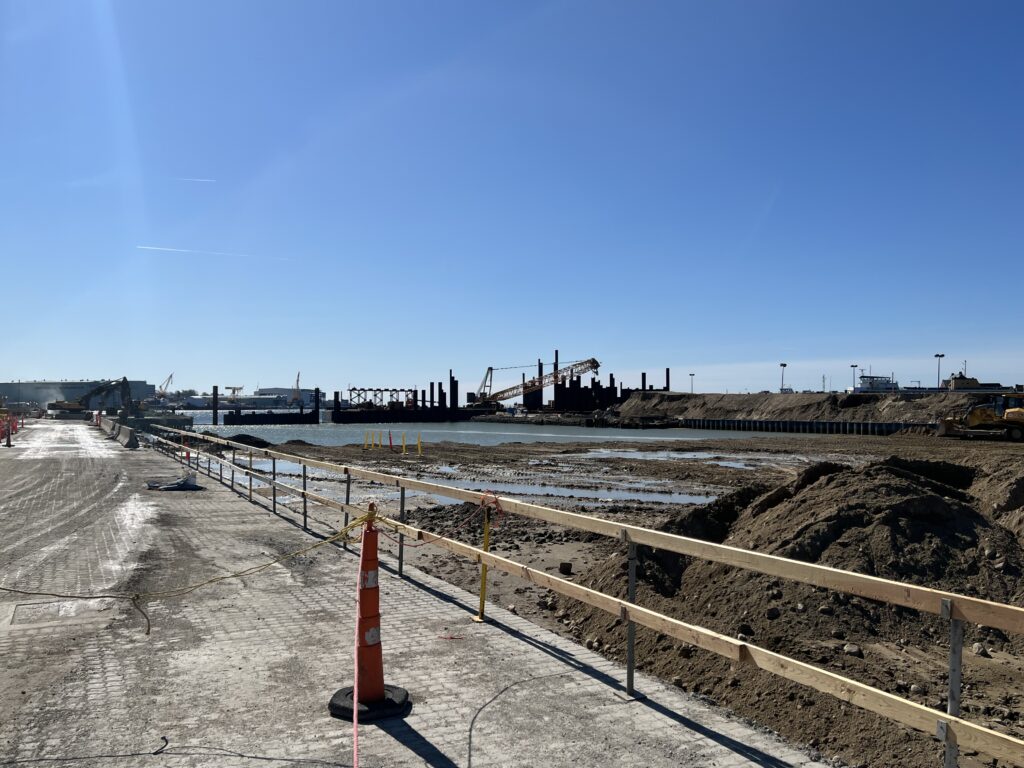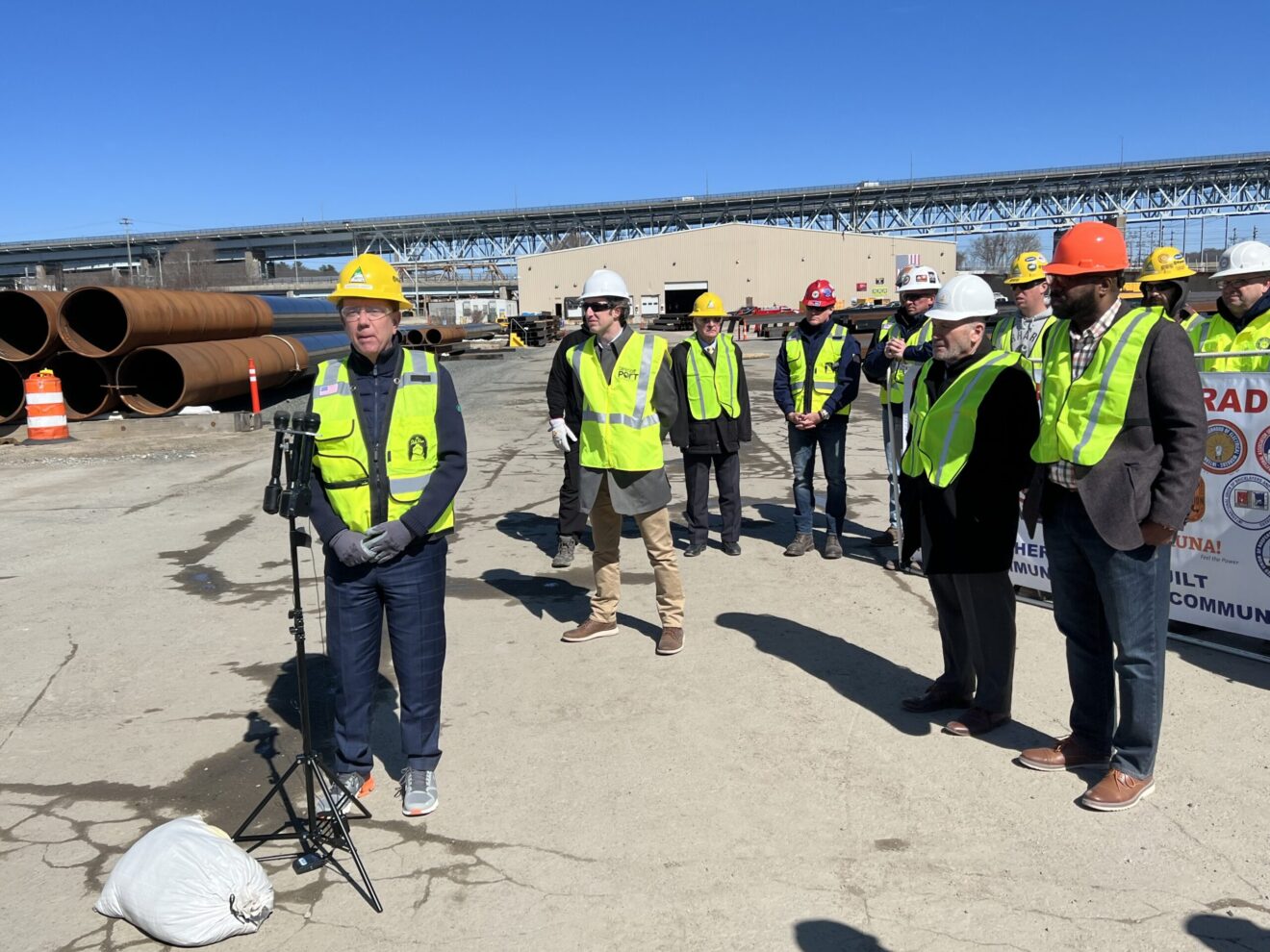NEW LONDON – Shortly after joining Gov. Ned Lamont at a press conference to celebrate progress toward redeveloping State Pier as a hub for constructing wind energy off the New England coast, Port Authority Chair David Kooris outlined additional figures that will likely push the project cost to about $250 million – far above the $93 million price tag originally pitched in 2019 and several million dollars higher than the $235.5 million projection given last year.
Speaking at the New London State Pier on Tuesday morning, Lamont signaled support for the additional funding. Lamont said the project was enormous – much larger than he thought just from reading about it – and that he understood that there are sometimes unforeseen circumstances or delays that increase costs.
“You’ve got to keep this in perspective. I think this is transformative for this state and our region,” Lamont said. “I think it’s one of the most important investments the state has made in many years, and we’re not doing it by ourselves – it’s a public-private partnership with [$75 million] coming in from our partners [Eversource and Ørsted].”
According to Kooris, the cost of permitting delays and keeping contractors on site amounted to $6.8 million.
Kooris said he expected another “comparable” cost would be added next month, after negotiations with the contractor Kiewit to speed up construction and ensure State Pier will be ready as the staging area for Eversource and Ørsted’s South Fork Wind Project in March 2023.
Kooris attributed the $6.8 million increase partly to several months of delays caused by road salt distributor DRVN, which was pushed off the State Pier to make way for the redevelopment and appealed permits for the redevelopment “at every step,” according to Kooris.
Kooris said that federal permits were also delayed, idling contractors and shifting the project timeline to accommodate those delays.
Kooris detailed earlier increases to the cost of the project. Kooris said the $93 million price tag was “committed funds,” and did not include soft costs that would have raised the estimate to about $120 million at the time.
Of that $93 million, the state originally agreed to match $57.5 million of private dollars with $35.5 million public dollars.

The project plans then were altered to accommodate the Cross Sound Ferry, costing another $35 million to move the heavy lift pad – the key to the redevelopment, meant to enable massive wind turbine blade components to be loaded onto a ship – to the other side of the pier, Kooris said. The increase to $235.5 million was more complicated and the result of a variety of factors.
Kooris told the board in a meeting held right after the press conference that the cost increase could have been much higher if they had waited until after receiving the final permit to start procuring materials and labor.
He credited their approach with saving millions buying steel alone that would have otherwise been lost to inflation.
“I’d rather that money goes into worker’s paychecks for increased labor time, then it go into increased material costs,” Kooris told the board.
While wharf is filled, promises of jobs remain unclear
At State Pier, the mood was upbeat as Lamont marveled at the progress of the project and envisioned turbine blades higher than the Gold Star Bridge being loaded onto Dominion Energy’s first-of-its-kind installation vessel to be brought out to the Atlantic Ocean and installed off the coasts of Rhode Island and Long Island. Lamont waxed poetic about returning New London to its former glory as one of the busiest ports in the Northeast.
“This is not about State Pier,” Lamont said. “This is about reimagining what New London could be, what this means for this part of Connecticut, what this means for our state and our country.”
Crews continued filling the area between the two piers and pilings to support the heavy lift pad – replacing water with mud, which will later be covered with gravel and rock until it is unrecognizable from its previous form.
How much economic development the new pier will spur remains to be seen.
At the very least, the pier will support jobs loading ships for Eversource and Ørsted’s three wind projects, which they have leased the pier to serve as a staging area for a cost of $2 million a year for 10 years, Kooris said.

The hope is that having New London set up as a staging area will lead to an offshore wind supply chain being built up around the city, creating more jobs – but for now the offshore wind developers will likely rely on importing parts from Europe where the supply chain is already more developed, Kooris said.
Kooris also said the redeveloped pier has potential to process more cargo than before, either during down times between offshore wind projects during the Eversource and Ørsted lease, or after their lease is up.
“For decades, we have known that we have had to upgrade this antiquated facility from the two finger piers to a larger port to attract a broad range of cargo,” Kooris said. “We’re going to have the ability to do that for generations to come, because of these improvements.”

